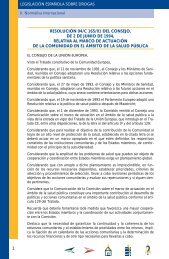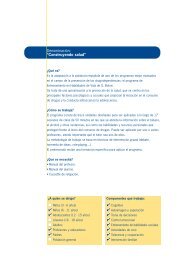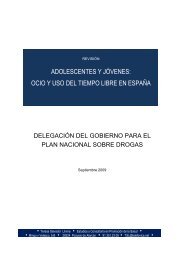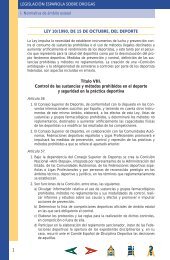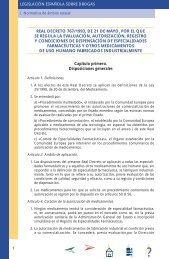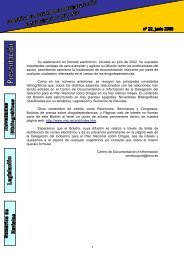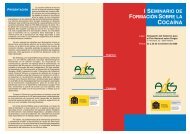1 Su elaboración en formato electrónico, iniciada en julio de 2002 ...
1 Su elaboración en formato electrónico, iniciada en julio de 2002 ...
1 Su elaboración en formato electrónico, iniciada en julio de 2002 ...
- No tags were found...
You also want an ePaper? Increase the reach of your titles
YUMPU automatically turns print PDFs into web optimized ePapers that Google loves.
JOURNAL OFCHILD & ADOLESCENTSUBSTANCE ABUSEVolume 13 Number 3 2004CONTENTSWhy Adolesc<strong>en</strong>t Problem Gamblers Do Not Seek Treatm<strong>en</strong>t…...……1Rob<strong>en</strong> LadouceurAlexan<strong>de</strong>r BlaszczynskiAmelie PelletierPreval<strong>en</strong>ce studies indicate that approximately 40% of adolesc<strong>en</strong>ts participate in regulargambling with rotes of problem gambling up to four times greater than that found in adultpopulations. However, it appears that few adolesc<strong>en</strong>ts actually seek treatm<strong>en</strong>t for suchproblems. The purpose of this study was to explore pot<strong>en</strong>tial reasons why adolesc<strong>en</strong>ts failto seek treatm<strong>en</strong>t for gambling problems. A semi-structured interview that inclu<strong>de</strong>ddiagnostic criteria for pathological gambling was administered to a sample of 265adolesc<strong>en</strong>t school stud<strong>en</strong>ts. Only one of sev<strong>en</strong> problem gamblers recognized his problemand none have sought help. From a youth perspective, it is clear that gambling does notconstitute or is not perceived to repres<strong>en</strong>t a major problem in their daily routine. The reasonthat adolesc<strong>en</strong>ts do not perceived gambling to be a problem may be linked to the abs<strong>en</strong>ce oany major adverse consequ<strong>en</strong>ces stemming from their gambling activities. These resultsindicate that efforts should be directed toward a primary prev<strong>en</strong>tion approach in reducingthe impact of gambling problems.KEYWORDS. Gambling, problem gambling, adolesc<strong>en</strong>ce, preval<strong>en</strong>ce, treatm<strong>en</strong>tEffects of Comorbidity on Treatm<strong>en</strong>t Processes and OutcomesAmong Adolesc<strong>en</strong>ts in Drug Treatm<strong>en</strong>t Programs…………….……13Christine E. GrellaVandana JoshiYih-Ing HserThis study examined the relationship betwe<strong>en</strong> treatm<strong>en</strong>t processes and post-treatm<strong>en</strong>tabstin<strong>en</strong>ce using data from the Drug Abuse Treatm<strong>en</strong>t Outcomes Studies for Adolesc<strong>en</strong>ts (N =810), with a focus on differ<strong>en</strong>ces betwe<strong>en</strong> adolesc<strong>en</strong>ts with and without a comorbid m<strong>en</strong>taldisor<strong>de</strong>r. The majority of the sample (62%) was diagnosed with at least one co-occurringm<strong>en</strong>tal disor<strong>de</strong>r, most oft<strong>en</strong> conduct disor<strong>de</strong>r. Overall, comorbid youth had more service needsand received more services compared with non-comorbid youth, and there were significantdiffer<strong>en</strong>ces in service <strong>de</strong>livery by type of treatm<strong>en</strong>t modality. Post treatm<strong>en</strong>t abstin<strong>en</strong>ceamong the comorbid youth was positively associated with rapport with counselors andparticipation in 12-step groups while in treatm<strong>en</strong>t.KEYWORDS. Adolesc<strong>en</strong>ts, comorbidity, treatm<strong>en</strong>t services, treatm<strong>en</strong>t processes, treatm<strong>en</strong>toutcomes



